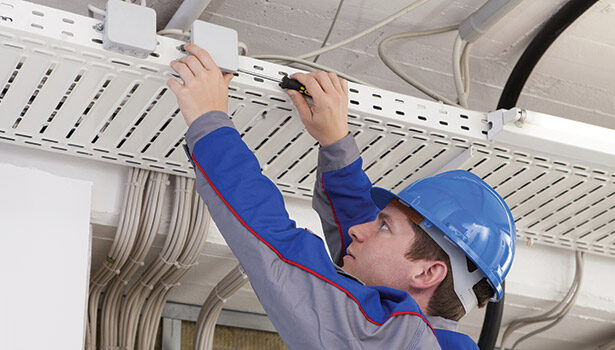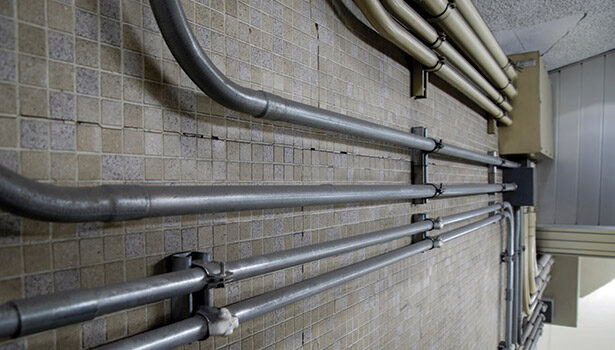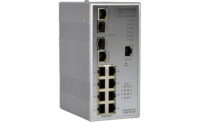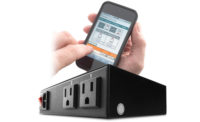Video Transmission & Power Management 101
Understanding and knowing how to evaluate the various technologies and products ensures the performance and reliability of video surveillance systems

Ethernet over coax (EoC) technologies provide a means for technicians to use existing legacy coax cable in IP video systems to avoid the difficult, time-consuming and expensive job of running new wire. PHOTO COURTESY OF NETWORK VIDEO TECHNOLOGIES

Because Ethernet cable’s transmission distance is limited to 100 meters (approximately 328 feet), it requires repeaters or extenders to cover longer distances. For installers, this can pose problems with sourcing power in what could be awkward locations within a facility. PHOTO COURTESY OF NETWORK VIDEO TECHNOLOGIES


No matter how great a video surveillance camera may be, if it has no power source — primary and/or backup — or can’t send images to the head end for viewing and archiving, it is no more useful for security than a painting hanging on the wall. This is why transmission and power solutions are crucial to providing the highest possible level of video security.
It’s not enough to simply run wire between the camera and head end or plug the camera into a wall socket. There are other important considerations for transmission and power — including distance, signal type and voltage requirements — that guide system design and product choices. Knowing what to look for in the various transmission and power product categories is essential for ensuring the performance of every video surveillance system.
But before learning the factors to use in evaluating products, you need to understand what each transmission or power solution does and its role within an overall video system. To help drive this understanding, we’ve provided a primer of sorts on some of the most common components. Even if you already know a lot about these technologies, you’re bound to find something new, whether information or advice, below.
Media Converters
A media converter is a simple networking device that connects two different media types, such as coax and fiber, allowing a variety of signals — including analog video, serial data, audio and Ethernet — to be transmitted using existing structured cabling systems. The transmission medium for Ethernet or IP signals can be copper, fiber optic or wireless/radio.
For IP systems, fiber is the best choice — particularly for new installations — based largely on its ability to transport large volumes of data, says Frank “Skip” Haight, vice president of marketing for Communication Networks (ComNet), located in Danbury, Conn.
“If you were to start a project from the beginning, I would select and install single-mode optical fiber. It gives the best return on investment, excellent data throughput and is the easiest and best way to transport gigabit Ethernet effectively over distance,” he says. “Whenever it’s installed, you will have the bandwidth capacity to transmit just about any volume of Ethernet data you should ever need.”
An alternative to fiber, Ethernet-over-coax (EoC) converters allow IP signals to be sent over existing cabling, which has a number of benefits. “The ability to accommodate IP cameras and edge devices over coax cabling has proven to be an extremely pragmatic solution and a cost-effective way to upgrade analog systems to a networked platform. And the ability to transmit data and deliver power extended distances over Ethernet cabling without repeaters provides added savings,” says Alan Forman, president of Brooklyn, N.Y.-based Altronix.
Additionally, EoC allows customers to avoid the cost of completing analog-to-IP upgrades in one fell swoop, says Guy Apple, vice president of marketing and sales, for Menlo Park, Calif.-based Network Video Technologies (NVT).
“Ethernet-over-coax allows the end user to choose when they would like to install IP equipment, because the migration can be done incrementally,” he says. “If one were to install an entirely new UTP network infrastructure, the project would be done in one pass. Legacy coax can be migrated from analog cameras to IP/megapixel cameras in the timeframe chosen by the end-user.”
There are a number of considerations when evaluating media converters, including where the equipment will be installed. Because converters are often installed at the edge, they must be able to withstand environmental elements such as shock, vibration and humidity.
“Like all edge devices, media converters should be hardened,” says Jim McLaughlin, vice president of product development, American Fibertek Inc. (AFI), Somerset, N.J. “Security equipment is rarely installed in a controlled environment.”
Ethernet Extenders (or Ethernet Bridges)
Not-so-Standard?One of the benefits of Ethernet and the IEEE802.3 operational standards is the premise that if all the equipment you’re using meets these standards, operation should be seamless. Unfortunately, says ComNet’s Skip Haight, in many cases it just doesn’t work that way. “The reality is: different manufacturers make their products just a little different, and interoperability comes with difficulty,” he says. The most likely way to ensure seamless operation, he advises, is to find a single source for all Ethernet transmission equipment, whether wireless, fiber optic, copper, switches and media converters. “In many cases, working closely with the product manufacturer and supplying them or working with them on the system design will allow configuration testing to happen before the installation,” Haight describes. “Working closely with the manufacturer allows interoperability issues that arise to be solved in the lab and not in the field. It’s also important to work with a manufacturer who has outstanding technical support and can handle any issues that arise in a timely and effective manner.” |
Related to (and in some cases incorporated into) media converters, Ethernet extenders or bridges are used to extend an Ethernet signal beyond the distance limitations of certain media. For Cat5/6 UTP cables at fast Ethernet transmission rate, this limitation is around 100 meters (approximately 328 feet), shorter for gigabit rates.
Many times, 100 meters or less simply doesn’t cut it in terms of transmission distance. To overcome this limitation requires changing transmission media to a type that offers greater distance, such as fiber or wireless. Another tactic would be to use repeaters or other equipment that allows distances to be extended over an existing media such as UTP or coax. This presents challenges, however.
“For the installer, if the transmission distance is longer, that typically means IDF (intermediate distribution frame) closets in odd locations throughout a facility to create the proper repeater data and/or power supply point. This usually involves installation of a lockable closet or NEMA (National Electrical Manufacturers Association)-rated box,” Apple says.
Distance can pose a real problem for analog-to-IP upgrades in particular, Apple adds.
“A typical analog camera has a transmission distance in excess of 500 feet, so with a 328-foot Ethernet distance limitation, that 500 feet would require at least one newly installed IDF with accompanying Ethernet extenders,” Apple says. “And don’t forget you have to place or supply power at the IDF/NEMA box, which involves added expense.”
For IP systems, long-range Ethernet adapters work well over single UTP or Ethernet cabling and deliver full duplex data transmission at 100Mbps over distances of up to 500 meters over structured cabling without repeaters — five times the distance of standard Ethernet cabling, Forman says. When used with UTP, these adapters can reach distances of 150 meters.
“Long-range Ethernet adapters allow CAT5e infrastructure to cost-efficiently accommodate IP cameras and edge devices over longer distances, or upgrade to network connectivity using legacy UTP infrastructure,” Forman says. “Deploying edge devices further from the head-end without compromising performance or having to use repeaters provides numerous installation, budgetary and security advantages.”
Wireless transmission offers a number of benefits, such as deployment without the costs associated with traditional copper or fiber systems, Haight says. There are no fixed costs for the media itself, the hardware transmission devices on each end, or the labor to install the system. “If you think of campus-type installation where multiple buildings are located, with wireless you can eliminate the costs for laying cable and disrupting the environment,” he says.
However, Haight adds, wireless is not a cure-all for transmission issues. “Wireless does have its challenges; location, obstructions, RFI/EFI can all pose problems with a wireless installation,” he says.
When sourcing media converters, the biggest consideration is to evaluate the application and determine whether there is existing cabling that can be used with an Ethernet converter, rather than having to rip and replace it with new cables. The next step is to determine what transmission media would be the best choice based on the layout of the site, available power, etc., and ensure that the media converter can accommodate that media.
“It also pays to use equipment with a very good warranty,” Haight says.
Network Switches
A network switch is a multi-port device that serves as a bridge to connect devices together on a network using a form of packet switching to forward video data to the destination device. Switches come in three varieties: managed, unmanaged and self-managed.
The main purpose of a managed switch is to allow users to configure the switch and prioritize LAN traffic to ensure that the most important information gets where it needs to go. In a security application, this means making sure critical surveillance video is delivered to the head-end for monitoring or storage without getting bogged down in heavy network traffic, Haight says.
Unmanaged switches simply allow Ethernet devices to communicate with one another and are often used as an aggregation point, collecting and forwarding the Ethernet data from the devices connected to it on to the network. These plug-and-play devices are shipped with a fixed configuration that cannot be changed, which limits flexibility.
There is another important factor to consider when determining if an unmanaged switch is right for an application. “The downside to an unmanaged switch is the potential to flood the network, as each connected device is continuously inserting data onto the network,” Haight says.
A self-managed switch is essentially a hybrid that can act as a network aggregation device like an unmanaged switch, but has built-in functions to prevent network flooding. The primary function of these switches is to combine Ethernet data from input ports and forward that data to the next device on the network.
Of the three, managed switches provide the greatest control over how data travels over a network, as well as who is permitted to access it. These switches also use protocols like SNMP (simple network management protocol), which can be used to determine the health of a network or the status of a particular device. This allows IT managers from a central site to monitor network performance to quickly detect and repair problems without having to physically interact with the switch.
Among the other important features of managed switches is redundancy. The spanning tree protocol (STP) incorporated in managed switches allows for one active path at a time between two network devices, preventing loops and establishing redundant links as a backup to prevent expensive downtime and keep integrated systems available, Haight says.
Power over Ethernet (PoE)
6 Real-World EoC ApplicationsTo illustrate the power of Ethernet-over-Coax (EoC), NVT’s Guy Apple provided these six examples of successful installations that used the technology. • A Fortune 50 software titan with more than 8,000 cameras worldwide has begun the process of migrating all of its analog cameras on existing runs of greater than 100 meters to megapixel IP cameras. Major reasons the company chose to use EoC were a minimizing of facility disruption and the ability to accomplish this project one facility at a time without the expense of major re-cabling. • A large casino in New York has migrated 1,200 analog cameras connected by coax to megapixel. The casino was able to maintain the maximum open floor space and revenue during the transition, due to the minimally invasive migration process. Only very small sections of the casino floor were closed during the project. • A Fortune 500 Bank with 180 branches in the Northeast U.S. has replaced analog PTZ cameras in each location’s lobby with a megapixel camera. Now they receive complete coverage of the lobby with much higher resolution. • A large school district in Florida is upgrading 55 schools from analog cameras on coax to IP and megapixel cameras. The integrator will be able to complete more schools more quickly at a lower cost because no cabling is required. In addition, the coverage area of the surveillance system will be increased to include areas previously left uncovered. • A national restaurant chain with 60 locations has exchanged each analog camera at every location for megapixel IP cameras. The transition was quick and did not interrupt normal business hours. • A large condominium complex in Bronx, N.Y., wanted two megapixel cameras in each of its elevators to provide maximum coverage and resolution. EoC allowed them to install two cameras on a single coax traveler cable. |
As just about anyone in the industry already knows, PoE is a technology that allows data and power to be provided to a device using a single Ethernet cable.
“PoE is a critical function in most networks that allows the devices on a network to receive power over the same cables that transmit the Ethernet data. Electrical operational power can only be transferred over copper media, and switches, media converters and power injectors can be the source of that power,” Haight describes.
What you may not realize is that PoE-type functionality can be extended to copper cabling using Ethernet over coax (EoC) converters.
“Ethernet over coax adapters provide a cost-effective solution to transmit IP video, data and power over coaxial cable, enabling legacy infrastructure to support PoE and PoE+ edge devices,” Forman says. “This technology can transmit IP full duplex data by itself or simultaneously with PoE, PoE+ and even high PoE at data rates up to 100Mbps.”
Because Ethernet/PoE repeaters have to be installed every 328 feet, this can add up to big problems for installers, who may be faced with sourcing power in odd locations throughout a facility just to create a proper repeater data/power supply point.
“This is usually a lockable closet that has no power mains installed, so now there is the cost of installing a power plug and mains,” Apple says. “A camera at 750 feet from the head end requires two repeaters, and these repeaters, their associated connections and the typical need for uninterruptible power supply (UPS) power, all add up to be a potential remote point-of-failure headache.”
With EoC-based PoE, 48 volts of power is provided at the control room and distributed to the EoC transceivers and IP cameras. With no repeaters needed, the problem can be solved without adding to the budget, Apple says.
“Many IP cameras can get power from the existing 24VAC distribution system. However, PoE adds value, increases customer options and can simplify the design. With EoC-based PoE, cameras can operate from the same UPS as the control room equipment,” he says.
There are currently two standards that define power output: IEEE802.3af, which designates 15 watts, and IEEE802.3at, which designates 30 watts. Due to the increased demand some devices require, up to 60 watts can be provided. However, installers should not rely on these standards alone in evaluating products, Haight says. (See related article “Not-so-Standard?” on page 62.)
“The power supply used to provide PoE power needs to provide the maximum load over temperature, and the power rating of the supply used should be two times the rated power at room temperature,” McLaughlin says. “For example, to deliver 30 watts at high temperature — above 70 deg. Celsius — a 60-watt supply should be used.”
Remote Power Management
Either a standalone hardware or combined hardware and software solution, remote power management systems (RPM) are relatively new solutions that allow users to reboot or restart locked-up devices without physically accessing them. Hardware-only solutions consist of a switch mounted to the exterior of a rack for on-site use, while combination systems consist of a hardware module with the addition of software that provides remote access for off-site power management.
“RPMs provide the convenience of being able to restart a locked up camera, DVR, NVR or access control system without having to roll a truck or send personnel to simply reboot a device. As long as a security manager has access to the Internet, they can restore security devices literally from anywhere in the world,” says Bill Allen, director of marketing at Carrollton, Texas-based Minuteman Power Technologies.
Uninterruptible Power Supplies (UPS)UPS provide instantaneous, temporary emergency power when a main power source fails, serving as a standby power source to ensure there is no gap in continuity while a more permanent standby power source is brought online. For blackouts, a UPS delivers power to critical systems and devices, including cameras, DVRs, NVRs, access control, emergency communication and fire alarm systems. It also provides additional functions that protect that equipment from power-related damage. “All electronic equipment, including security devices, is vulnerable to power issues such as blackouts, surges, spikes and brownouts,” Allen says. “The UPS also provides surge and spike protection, along with voltage regulation during brownouts.” For a four-, eight- or 16-camera system, a small-capacity UPS will provide emergency power for 10 to 30 minutes depending on its capacity and the equipment’s power usage. For larger systems with hundreds of devices, multiple rack-mounted UPS should be used. When specifying or purchasing a UPS, Allen says, it’s important to calculate the total power requirements of a device or system since UPS have maximum capacity restraints. “The total power load has to be considered,” he says. “UPS capacities are generally listed in volt amps or VA, but watt ratings or amp ratings can also be used to calculate the total load.” As security systems become more complex and widely distributed across a campus or in a remote office location, the challenge of managing these numerous devices becomes more challenging, Allen says, adding that power is obviously critical to making sure a security system — including the UPS system — is fully functional, no matter the power conditions either in a local office or remote location. Thankfully there are ways to deal with that challenge. “There are a number of tools that can make life easier for security managers and their personnel. Having visibility into power conditions and being able to monitor and manage devices is important,” Allen says. “An industry-standard, manufacturer-agnostic monitoring and management tool in the IT sector is simple network management protocol, or SNMP. This technology has been in use for 15-plus years and is currently making its way into the security world. SNMP runs on the backbone of a network and allows communication and control of widely distributed devices.” Allen says one of the best available resources for determining the correct UPS can be found online at SizeMyUPS.com. The site provides users with access to a database of security equipment to assist in calculating the full system load, and also provides accurate battery backup times in minutes based on the calculated load. |
In addition to power management, RPM systems can monitor a host of other functions to ensure continuity in video surveillance.
“Ideally, a remote power management system should function as a security installation problem-solver that improves system reliability, saves time and reduces service costs,” says Rebecca Villareale, PR manager for Fairfield, N.J.-based Middle Atlantic Products. “It should monitor the power and temperature conditions of installed systems, log key conditions, and alert users to any irregularities. And based on simple setup instructions, it should even be able to reboot specific devices or take other actions to correct problems on their own when on-site maintenance personnel aren’t available.”
When choosing an RPM solution, Villereale says it’s important to look for products that feature extensive monitoring to provide installers with the highest level of flexibility and intelligent power monitoring. The solution should be capable of maintaining security system reliability through automatic actions that include programmable sequencing, emergency power-off with automatic recovery/reboot options for individual outlets and dry contacts, and auto shutdown of equipment in over- and under-voltage events and over-temperature conditions while providing automatic recovery and completing necessary actions such as turning on emergency fans.
Additionally, RPM systems should offer plug-and-play functionality and be able to be configured and managed for any level of system, ranging from simple to complex, with local or remote capability through a browser-based interface. Ideally, accessibility should range from local to RS-232, remote and Web browser, she says.
There are a number of other considerations, but the bottom line is that an RPM solution must provide proactive power management and instantaneous insight and control from any location, and deliver the level of protection to avoid damage or interruption of service caused by electrical spikes or surges, Villereale says.
“Ultimately, your remote power management system should be easy to set up and completely responsive on every level, but also be able to monitor a specific network video recorder, server or camera, detect that it is unresponsive and automatically restart the device and send you an alert email,” she says.
When it comes to transmission and power management for video systems, flexibility has become the standard. Newer “IP over any cable” technologies have removed some of the complication from the process of choosing equipment. These solutions, including media converters, EoC and others, allow installers to use legacy cable, whether coax, UTP or copper, for IP migration, providing installers and integrators with time- and cost-reducing options for migrating from analog to IP or overhauling systems.
“Basically, this technology allows you to use whatever cable is available and in decent shape,” Apple says. “Native to most building cabling infrastructures is the fact that there have been, over time, hosts of cabling types and sizes installed. One may think that this is just a mess. Others may think it is a resource to be used. IP over any cable technology allows multipoint network operation using any star or daisy-chained cabling topologies and with any combination therein. So, connect UTP to coax, to UTP and back to coax in any topology one runs into with no problem.”
In addition to transmission, these solutions provide added power benefits that eliminate the need for extra equipment or awkward placement of equipment.
As equipment continues to evolve and advance, the capabilities of systems will expand, making it important to consider the future when choosing transmission and power components. “I think as IP technology continues to improve, you can be sure the volume of Ethernet data being transported will expand. Choosing a medium with the highest capacity initially will pay off in the future,” Haight believes.
Looking for a reprint of this article?
From high-res PDFs to custom plaques, order your copy today!







